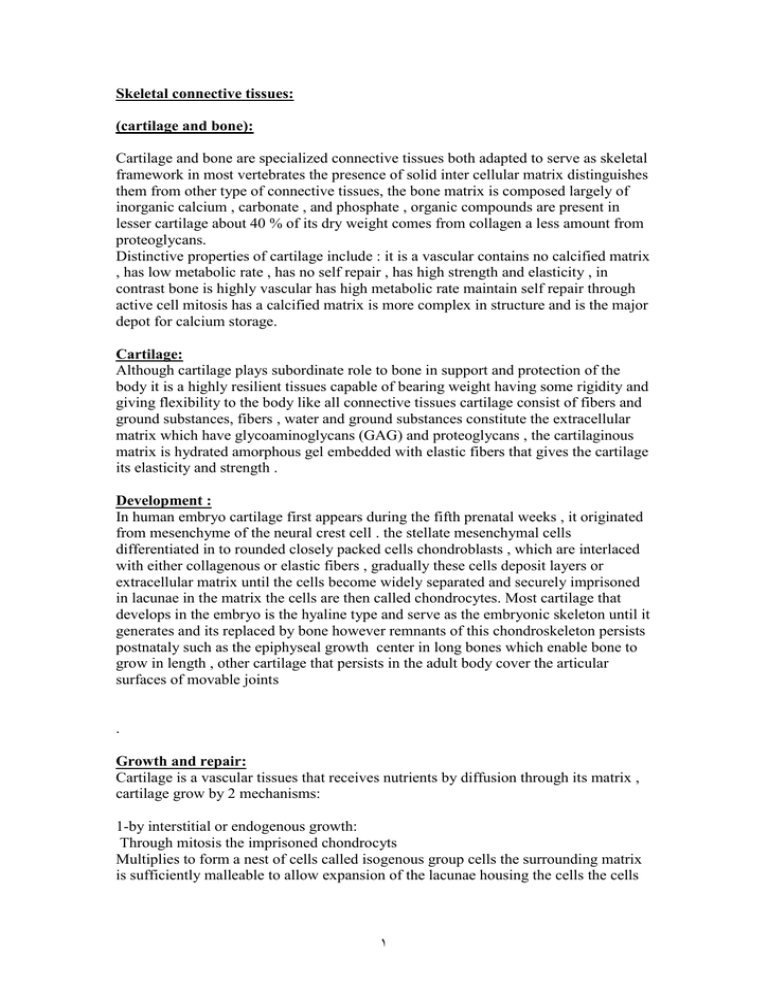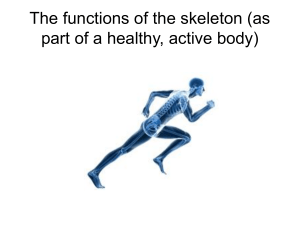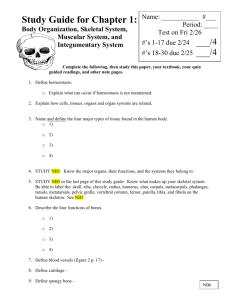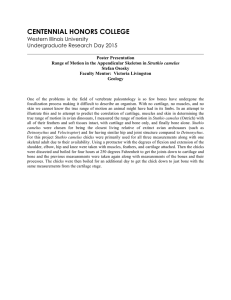Cartilage and bone are specialized connective tissues both adapted to... framework in most vertebrates the presence of solid inter cellular... Skeletal connective tissues:
advertisement

Skeletal connective tissues: (cartilage and bone): Cartilage and bone are specialized connective tissues both adapted to serve as skeletal framework in most vertebrates the presence of solid inter cellular matrix distinguishes them from other type of connective tissues, the bone matrix is composed largely of inorganic calcium , carbonate , and phosphate , organic compounds are present in lesser cartilage about 40 % of its dry weight comes from collagen a less amount from proteoglycans. Distinctive properties of cartilage include : it is a vascular contains no calcified matrix , has low metabolic rate , has no self repair , has high strength and elasticity , in contrast bone is highly vascular has high metabolic rate maintain self repair through active cell mitosis has a calcified matrix is more complex in structure and is the major depot for calcium storage. Cartilage: Although cartilage plays subordinate role to bone in support and protection of the body it is a highly resilient tissues capable of bearing weight having some rigidity and giving flexibility to the body like all connective tissues cartilage consist of fibers and ground substances, fibers , water and ground substances constitute the extracellular matrix which have glycoaminoglycans (GAG) and proteoglycans , the cartilaginous matrix is hydrated amorphous gel embedded with elastic fibers that gives the cartilage its elasticity and strength . Development : In human embryo cartilage first appears during the fifth prenatal weeks , it originated from mesenchyme of the neural crest cell . the stellate mesenchymal cells differentiated in to rounded closely packed cells chondroblasts , which are interlaced with either collagenous or elastic fibers , gradually these cells deposit layers or extracellular matrix until the cells become widely separated and securely imprisoned in lacunae in the matrix the cells are then called chondrocytes. Most cartilage that develops in the embryo is the hyaline type and serve as the embryonic skeleton until it generates and its replaced by bone however remnants of this chondroskeleton persists postnataly such as the epiphyseal growth center in long bones which enable bone to grow in length , other cartilage that persists in the adult body cover the articular surfaces of movable joints . Growth and repair: Cartilage is a vascular tissues that receives nutrients by diffusion through its matrix , cartilage grow by 2 mechanisms: 1-by interstitial or endogenous growth: Through mitosis the imprisoned chondrocyts Multiplies to form a nest of cells called isogenous group cells the surrounding matrix is sufficiently malleable to allow expansion of the lacunae housing the cells the cells 1 lay down more extracellular matrix and interstitial growth occurs as they becomes separated by the new matrix. 2-Apositional (exogenous) growth occurs when cartilage structure increase in size by new cartilage being deposited by its surface , this growth is dependent on the presence of undifferentiated primitive cells on the surface of the cartilage. these cells differentiate into chondroblast which lay down new cartilage except in epiphyseal plates , Because cartilage has no blood supply it has very slight regenerative capacity if fractured cartilage usually repairs it self by fibrous scar formation derived from the perichondrium and not by extensive new cartilage production. Types of cartilages : Classification of cartilage depends largely on the character of the matrix and the predominant type of fibers present , using these 2 criteria 3 type of cartilage can be identified under the light microscope hyaline(no fibers visible) elastic (with elastic fibers) and fibro cartilage (with dense collage nous fibers) 1Hyaline cartilage Hyaline cartilage is the most common type and is the prototype for all cartilage the other type is simply variations on its generalized structures it is called hyaline because in the fresh state it has glassy translucent , bluish, white appearance in the embryo it forms most of the temporary skeleton that is replaced by bone in the adult it persists as the articular cartilage of the movable joints ,the cartilage of the nose, trachea , and bronchi, and the larynx . All hyaline cartilage except in the articular cartilage is covered by a layer of dense connective tissues the perichondrium which is essential for the growth and maintained of the cartilage . Cartilage cells or chondrocyts in groups in lacunae these cells are flattened and lie parallel to the long axis in the cartilage these chondrocyts nearer to the center of cartilage mass are rounded or avoid . each cell has a large spherical nucleus with one or more nucleoli .cytoplasm of chondrocytes appears granules and is basophilic this due to abundance ribosome's , mitochondria, and r ER, ribosome's are well developed Golgi complex large mitochondria are limited some fat droplets are found 2 A Hyaline cartilage (B) Elastic cartilage Elastic cartilage are similar to hyaline cartilage except that: 1-the matrix contains with elastic fibers which give the tissue flexibility . 2-It is yellow in the fresh state owing to the abundance of elastic fibers also it is more opaque than hyaline cartilage 3- The cells are resemble of that in hyaline cartilage except that they are more closely packed and usually are found singly in lacunae 4- Normally it is not calcify or ossify in old age as dose hyaline cartilage. 5- it shows less accumulation of glycogen and lipids. 3 Elastic cartilage is surrounded by perichondrium , growth occurs both appositionally from the perichondrium and interstitially by mitosis of chonrocytes internal to the perichondrium . Elastic cartilage is found only in few isolated area of the body where extra flexibility and support are needed ex: epiglottis . A (B) Elastic cartilage Fibrocartilage: 4 Fibrocartilage is an irregular dense fibrous tissue with thin dispersed encapsulated cartilage cells embedded with in it, these chondrocytes are usually found in short parallel rows but may be occurs singly in pairs or occasionally in small clusters because it has no perichondrium , fibrocartilage never occurs alone it blends with adjacent connective tissue structures especially those associated with joints for example it blends with the articular (hyaline) cartilage of joints and with certain tendons where they insert with bone. Fibrocartilage is found in the invertebrate disk and other associated disk in the knee , mandible , it matrix stain acidophilic because of the concentration of type 1 collagen fiber bundles amorphous ground substances is scantly , it is best seen at the a boundaries of the lacunae fibrocartilage develops from dense fibrous tissue richly populated with fibroblasts that are separated by considerable matrix when these fibroblast differentiated into chondrocytes fibrocartilage 5








